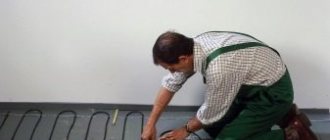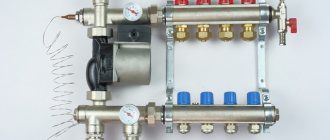The heated floor system is widely used today in the design of residential premises. Such heating helps to distribute the temperature evenly and maintain a comfortable microclimate in the room. The choice of system and its installation technology depend on the type of floor covering.
Let's figure out how to make an electric heated floor under tiles and indicate acceptable installation methods. In addition, we will provide step-by-step instructions on arranging underfloor heating and describe the important points of connecting the system to the power supply.
Choosing the best option
You can heat the floor covering using a heating cable or thermomat. Each option has its own advantages and disadvantages, which you should know about before going to the store.
Cable electric underfloor heating has a lower cost, but it is quite difficult to correctly calculate the cable length and install it. In addition, laying a cable heated floor under the tiles involves installing a thicker floor screed, which will lead to a decrease in the height of the room.
A heating mat is an improved version of a conductor and therefore has great advantages. Among the design features, we can highlight the placement of the cable on a special mesh made of fiberglass fabric with an even pitch between the turns.
One of the advantages of a thermomat is the simple calculation of the material; for this, it is enough to know the area of the room. Using this parameter, a roll of the required size is purchased in a specialized store.
Kinds
Modern models are represented by cable systems or mats. Infrared flooring is included in a separate category. It has several varieties - such systems can be film or rod.
Each of these types of floors has the following characteristics:
- a dry base is required for installation;
- The system must be grounded;
- equipped with temperature regulators;
- used as additional heating.
The differences include installation features, quality of heat generated, and requirements for the finishing coating.
Cable heated floor
Thanks to their reliability and safety, cable systems have become very popular. They have a simple device:
- the cable, distributed in sections, is mounted on a concrete screed under the finishing coating;
- a sensor that controls the temperature is also placed here;
- the ends of the temperature sensor and heating element are connected to the controller.
Such a system turns on only when necessary - when the temperature drops to a predetermined minimum.
Cable floors come in the following varieties:
- direct action systems - the cable is in a screed, located very close to the finishing coating;
- heated floors for wooden floors;
- heat storage system - used in rooms in which it is not prohibited to use electricity during low tariff periods.
Cable systems are installed separately for each room.
Thermomat
These floors consist of a thin heating cable attached to fiberglass. The heating core is surrounded by a screen and an insulating layer.
The mats are produced with single- and double-core cable. The latter option is more suitable for bedrooms and children's rooms. This is explained by the fact that two-core mats have a low level of electromagnetic radiation.
A thin cable floor is installed on top of the dried screed. Thermal mats are often installed under tiles. Penetrating through the mesh, the glue reliably secures the finishing coating.
Thermal mats do not affect the floor level, since they seem to “sink” into a layer of tile adhesive. The mesh becomes a kind of reinforcing frame. Another advantage of thermomats is ease of installation. They are laid when there is no desire to raise the floor.
Cable floor heating thermomats differ in that they are usually not used for main heating. In addition, if when making a cement screed the load on the floor will be quite large, it is better not to use cable systems. In this case, thermomats are used.
Infrared floors
Rod and film products are types of infrared heaters. When current passes through an element, electromagnetic waves begin to appear. Their range is 5-25 microns. They heat any objects located in the wave propagation zone. Conductive elements transfer heat to the overlying floor covering, furniture and walls, which heat the air.
Infrared floors are very energy efficient because they are able to convert about 95% of the emitted energy into heat. Heating of any surface occurs in a few minutes. If one segment is mechanically damaged, the rest continue to work.
Installation of heated electric floor
Laying cables and mats is carried out according to the same scheme, only the basic processes differ. At the same time, it is very important to understand how to properly install a heated floor under the tiles.
Surface preparation
To ensure high-quality installation work, you should pay careful attention to the surface preparation stage.
- The old coating is removed and the surface is cleaned of debris, dirt and dust.
- If there are unevennesses, make a rough floor screed. To do this, level the surface with a solution, the thickness of which can be about 7 cm.
Selecting a heating element
The basis of a heated floor system are heating elements, presented in the form of mats, cable or infrared film.
Work on forming the floor must begin with the selection of a cable that will provide the highest quality heating.
Heating cable
Two types of cables are suitable for organizing a heated floor:
- Resistive.
They emit the same amount of heat along their entire length, but when overheated they create a risk of burnout. The most budget option is a single-wire resistive cable. Two-wire costs a little more, but is easier to install;
- Self-regulating.
Able to regulate the amount of heat generated depending on the temperature of its own heating. The price of such a cable is higher than that of a resistive cable, but it works more reliably.
Both types of thermal cables are laid in two ways - snake and snail.
Important! Due to the risk of overheating, resistive cables are laid in such a way that they go around large appliances that generate heat.
Cable mats
The mats are the same heating cables, but already laid in a certain way on a reinforced plastic mesh. The installation of the mats is simplified as much as possible - they are laid out according to the developed pattern directly on the floor base, and the tiles are laid on top using glue.
The direction of laying is not of fundamental importance. Mats can be rolled out along both short and long walls.
The disadvantage of cable mats is their inertia - the floor warms up quickly, but cools down just as quickly. Therefore, thermomats are more suitable as an auxiliary rather than a main source of heat.
Carbon mats
The carbon system is based on the use of an infrared emitter with a heating element in the form of graphite-silver rods. They are connected to each other via a highly secure cable with a core of stranded copper wire.
The carbon rods are covered with a polyester or polyethylene shell on top, and carbon paste is located inside.
When the mat is powered from the mains, the paste heats up and begins to radiate heat.
Externally, carbon mats look the same as cable mats, but with fewer jumpers. The technology of their installation is no different. The advantage of the system is that the cables are connected to the conductor in a parallel circuit, so if one element fails, the rest continue to function.
But practice shows that infrared emitters quickly burn out at the joints, so many builders prefer not to use a carbon system for floor heating.
Infrared film
Another option for infrared heating is carbon film, the operating principle of which is similar to carbon mats. Thanks to its minimal thickness, the system saves space while providing high-quality heating.
Infrared film can be laid dry at any stage of repair work and turned on immediately after installation. But this type of heating element has a number of disadvantages. It separates the laid tiles from the adhesive base, which can lead to deformation of the cladding.
In addition, in situations where cement mortar is used for laying tiles, the film corrodes and becomes unusable.
Advice! Film flooring is more suitable for laying under linoleum, parquet or laminate. If you still need to lay the film under the tiles, it is better to choose perforated material.
Drawing up a laying scheme - how best to lay a heated floor
A wiring diagram for an electric heated floor is necessary for the correct placement of the heating mat or cable. It is drawn up before installing a warm floor under the tiles and calculating the required amount of materials.
When drawing up a diagram, you must adhere to the following recommendations:
- The distance from the walls to the contour of the heated floor should be at least 10 cm.
- Do not place the material under furniture without legs or household appliances. In this case, the heat given off will return back, which will cause the conductor to overheat and fail.
- Laying can be done not only in a straight line. Trimming individual sections of the grid allows you to direct the path in the desired direction. As a result, a certain area is heated, which helps reduce energy costs.
Principle of operation
The system is a thin film, between the layers of which carbon strips are laid. They are the heating elements. Laying is carried out on a pre-prepared base, the system is connected to the power supply and begins to heat up. Heating of all elements located around the film occurs due to infrared radiation.
IR floor design
Due to the small thickness of the film, the floor surface heats up very quickly and is turned off by the thermostat, working about 20 minutes per hour. When the room temperature drops, the system starts working again and warms up the base. Compared to other types of heaters, IR flooring is highly efficient, consuming very little electricity.
Comparison of water and film floors
The system can be used in any room, taking into account the arrangement of furniture: the film does not go under large and heavy objects. It’s easier to use it only in places where your feet come into contact with the tile surface, for example, at the exit from the bathroom.
There is another type of film IR floor - bimetallic. It is not allowed to be laid under tiles!
Rules for performing calculations
Before laying an electric heated floor under the tiles with your own hands, you need to make the correct calculations:
- If the system is used as the main heating, then to heat an area of 1 sq. m. requires a heater with a power of 140-180 W.
- If the heated floor will be used for additional heating, then you can use a heater with a power of 80 W or more.
In both cases, the quality of the room's thermal insulation is taken into account.
When performing calculations, it is necessary to calculate the usable area of the room. To do this, multiply the length of the room by its width and subtract the area occupied by household appliances and furniture without legs. Then, in accordance with the obtained values, the total power of the heating element and its length are calculated. Depending on the manufacturer, the power of 1 meter of heating cable is 16-21 W.
The choice of heating mats follows a similar principle; the usable area of the room and the total power are also taken into account. To attach thermomats to a concrete screed, an additional purchase of a special mounting tape is required.
Installation of thermomats
A standard heating mat kit consists of two elements:
- Thermal mat on a roll with power cable.
- Corrugation with a metal probe and a plug - for installing a temperature sensor inside it. It is needed to protect the sensor from alkali and moisture. If a layer of tile adhesive does not allow the installation of corrugation, a special moisture-resistant sensor is purchased.
Standard system equipment
Additionally you will need to purchase:
- Thermostat. Selected based on maximum power consumption.
- Mounting boxes if the thermostat will be installed in the wall.
- Remote temperature sensor (usually included with a thermostat). It is better to take a contact sensor rather than one that will measure air temperature.
- Wires for connecting the thermostat to the network. The cross-section is selected depending on the power of the system and the material of the wire (see table below)
| Wire cross-section, mm2 | 1,5 | 2,5 | 4 | 6 |
| Maximum power (copper wire), kW | 3,5 | 5,5 | 7 | 9 |
| Maximum power (aluminum wire), kW | 2 | 3,5 | 5,5 | 7 |
Basic Rules
The connection must be made through a thermostat to maintain the set temperature.
According to the Electrical Installation Rules (PUE), it is mandatory to install an RCD (residual current device) with an operating current of 30 mA, 100 ms and a circuit breaker of max 10 A (type C). It is recommended to connect systems more powerful than 2 kW through separate wiring with a machine.
If you are installing in a bathroom or other damp room, the thermostat should be located in an adjacent dry room.
The cable must not be shortened or cut! If necessary, you can cut off only the supply wire.
The photo shows possible installation schemes on an existing coating or a regular screed
System installation sequence
Determine where the thermostat will be installed on the wall and the area where the thermomat will be placed. There should be no furniture without high legs, plumbing fixtures or household appliances above the heated floor. If the screed has damping joints, the mat should not pass through them. A separate thermostat and mats are used for each room. If you plan to make several topcoats with different properties in a room, you need to install a separate thermostat for each of them.
A standard temperature sensor is installed inside a corrugated tube. To prevent it from creating additional unevenness, a groove is made for it in the floor and wall. The end of the corrugation is closed with a plug to prevent the solution from getting inside. The end of the sensor should be installed at a distance of 50-100 cm from the wall, slightly below the mat, centered between two turns of the cable. Do not bend the corrugation with a radius of less than 5 cm to allow the sensor to be replaced.
Installing a temperature sensor
The moisture-resistant sensor is simply fixed on the mesh centrally between the two cable cores. The disadvantage of installing without a corrugation is that if it breaks, you cannot easily replace it.
Before laying the heating mat, you need to coat the concrete floor with a primer to remove dust from the surface and increase the adhesion of the tile adhesive.
Place heating mats on the selected heating zone. To get the desired shape, you can cut the mesh and wrap the cable, but you cannot cut it. The mesh is attached to the floor with tape or staples, with the cable facing up.
An example of cutting and laying a thermomat
Retreat at least 5 cm from walls and adjacent mats, and 10 cm from other heating devices.
After laying the cable, you need to measure the ohmic resistance using a multimeter. It should be within the limits (plus or minus 10%) that are written in the manufacturer’s instructions or warranty card.
Connecting and installing the thermostat
System connection diagram
Connecting the heated floor and thermostat to the network should only be carried out by a professional electrician with the voltage turned off.
Strip the insulation at the output of the mounting wires from the mat and the power wire from 220V by 5-7 mm.
Connect the wires to the thermostat terminals according to its connection diagram, which is indicated in the instructions.
The cable's braided shield must be connected directly to ground.
Laying tiles
Laying can be done directly with tile adhesive, or the mats can be pre-filled with screed (at least 2 cm thick). It is prohibited to lay tiles on a substrate made of chipboard, plywood or other material.
- Apply tile adhesive directly to the mat. In damp areas (for example, a bathroom), first apply a thin layer of glue to the mats. After it hardens, waterproofing and a second layer of glue are applied.
- It is advisable to use special adhesive mixtures for heated floors, they are more elastic.
- Spread the glue evenly with a notched trowel. For this case, it is recommended to use only plastic combs to avoid damaging the cable.
- Press the tile or porcelain tile onto the glue, leveling it. The thickness of the tile adhesive together with the tiles should be at least 2 cm. Some manufacturers (for example, DEVI) recommend making a covering layer of at least 5 cm. This is due to the fact that with such a layer the heat will be distributed evenly.
Checking the electrical wiring
Before laying a heated floor under the tiles, you should check the functionality of the old electrical wiring. After all, to heat a large room, you need a powerful heater, which during operation will put a significant load on the wiring. Therefore, it is important to correctly determine the cable cross-section and find out whether it matches the new heating system.
If necessary, the electrical wiring in the room should be replaced with a more powerful version. In addition, appropriate RCDs and circuit breakers are additionally installed.
How to properly lay insulation on the floor under tiles
The first stage of direct installation of heating elements is floor insulation. The efficiency of the entire system and the cost-effectiveness of its use depend on the quality of the work performed. The most popular among thermal insulation materials used for underfloor heating systems is penofol. This roll insulation has a self-adhesive layer and a foil coating. For insulation, the material is rolled out and glued to the surface, the joints are taped with foil tape. To increase the thermal insulation characteristics of the room, foam foam is overlapped on the walls by several centimeters.
After laying the insulation in the lower part of the walls, a damper tape is glued around the perimeter of the room. It compensates for the expansion of the floor covering when heated.
A metal mesh is laid on top of the heat-insulating material to prevent the heating element from coming into contact with the insulation and to simplify the installation of the heated floor under the tiles.
Features of underfloor heating
There are two types of heated floors:
- using water heating;
- electric.
In the first case, the solution is more economical in operation - after installing the heated floor, it can be connected to the existing heating system. However, installing such a heated floor is a more complex and expensive procedure compared to the second option.
Heating a tiled floor can be considered as an additional heating system in an apartment.
Laying a concrete screed Source narobraz.ru
Installation of control devices
Special devices help control the operation and manage the system: a thermostat and a temperature sensor. The thermostat can be mechanical or electronic; with its help, a certain temperature regime and the time for turning the system on and off are set. This device is placed in close proximity to sockets, mounted in the wall.
It is recommended to place temperature sensors on the floor. To install this device, a vertical hole is drilled in the wall from the thermostat to the temperature control point, into which a sensor is placed, previously placed in a corrugated insulating pipe. The control location must be chosen between the heater turns.
The use of corrugation avoids unexpected damage to the sensor. In addition, this design provides quick access in case of an emergency. One end of the corrugated pipe is located in the concrete screed, so there is a risk of solution getting inside. To avoid this, the end of the corrugation is filled with sealant.
Installation of thermostat and sensors
The controller, which regulates temperature indicators, is installed in a specially designated place. The cable connecting the thermostat and the system elements must be placed in a corrugation. The corrugation is located in the pipe. It must be carried out to the temperature sensor. It should be mounted at a distance of 30 cm from the wall. If this condition is not met, temperature measurement will be complicated.
The corrugation is laid in such a way that no kinks are formed. They happen especially often near the baseboard. The edge that abuts the system should be sealed with sealant. This will prevent concrete mixture from getting into it.
In addition, a temperature sensor is placed in the corrugation. This improves the maintainability of the device.
Fixing heating cables or mats
After complete preparation of the surface, you can begin laying and securing cables or heating mats and directly deciding how to lay a heated floor under the tiles.
The cable can be secured using mounting tape and special plastic clamps. The use of these elements makes it faster and easier to fix the heating cable. During the installation process, it is necessary to maintain the same distance between the turns, otherwise the floor will heat up unevenly.
In heating mats, a certain pitch is maintained between the turns, so their installation is much easier and faster. It is enough just to arrange the material according to the diagram and make the correct connection to the thermostat.
After fixing the heating element to the floor, it is necessary to test the operation of the system and measure the resistance using a multimeter. The readings obtained must correspond to those recorded before laying the material.
Rules for safe operation
In order for a heating system made of infrared film to operate safely and provide comfortable conditions in the house, it should be installed in compliance with the following technology:
- installation is carried out only on a dry and flat surface;
- between the coating elements it is necessary to maintain a distance of at least 50 mm;
- mandatory grounding device;
- install a thermostat and film floor of the same power;
- The heating elements should be connected directly from the heating element and powered directly from the electric meter.
Heating a house or apartment using underfloor heating film is quite efficient and economical, and can create comfortable living conditions. You can install the system yourself; the main thing is to strictly follow the installation rules and manufacturer’s recommendations.
Screed
One of the stages in solving the question of how to lay a warm floor under the tiles is pouring the screed. To prepare a concrete solution, you will need materials taken in the following ratio:
- Sand - 4 parts.
- Cement - 1 part.
- Crushed stone - part 5.
- Water – 0.6 parts.
In addition, it is necessary to add a special plasticizer, which will make the solution more elastic. The additive is taken in an amount of 1% by weight of cement.
The total thickness of the screed should be no less than 3 cm and no more than 5 cm. The poured solution is left until completely dry, which most often takes about a month. Premature activation of the system is not allowed.
It should be remembered that the screed is made only when using a heating cable. You can immediately apply tile adhesive to thermomats.
How to choose the right system
In order to decide which warm floor for tiles is best to choose, you need to determine your preferences. To do this, you need to take into account the following:
- Since we are talking about installing a heating system, it is necessary to determine what power it should have. Can be used as the only or additional heating unit in the house. In these cases, power requirements will vary.
- You need to decide how much you need to use the screed. Although it provides reliable protection for heating elements, in some cases it can create additional inconvenience. There are alternative options for making the top layer of the floor.
- When analyzing the situation, you need to take into account the type of room. in which the installation will take place. In a city apartment there are more restrictions to choose from compared to a private house.
- You need to decide what level of costs the owner can afford. In this case, it is necessary to consider not only the cost of the installation, but also how much it will cost to operate.
If the house uses tiles for the floor, then installing heating under it will not only warm up the apartment better, but also make it possible to walk on it without fear of freezing. The latter is especially important when it comes to the bathroom.
When thinking about how to choose a heated floor, you need to try to ensure that the system can be repaired at minimal cost.
About water heated floors
It is a pipe system through which heated coolant circulates. The pipeline is located between the base of the floor and the top covering. Water is used as a coolant. It can be taken from the heating system, or special equipment can be used for heating. As the water passes through the pipes, it gradually cools, so in such systems it is not recommended to use pipes that are too long. During installation, metal or polymer pipes are usually used. When choosing them, reliability and durability play an important role, because in the event of a leak, complex and expensive repairs will have to be performed.
The water floor is connected to the heating Source rmnt.mirtesen.ru
The operation of such floors is relatively economical. Their use makes it possible to reduce energy consumption. This value in different cases can be 20-60% depending on the specific situation. The coolant temperature during operation does not exceed 50-60 degrees.
The installation is quite complicated and requires the participation of specialists. The water heated floor is a multi-layer structure. When installing them, it is necessary to ensure high-quality thermal insulation so that the heat does not escape outside the home.
If a heated floor is installed in a residential building that was left for several days during frost, then there is a danger that the liquid in the pipes may freeze. To prevent this from happening, the system is left turned on for this time at a reduced coolant temperature or liquid is pumped out of the pipes during absence.
Installation of a water floor Source my-climate.com.ua
Cable heated floors
In this case, the heating element is an electrical cable. After laying it, a cement screed is made. When using this option, its thickness will be minimal - no more than 5 centimeters. This floor heating option is considered one of the easiest to install. To operate such a system, it is enough to use 220 volt power. During operation, a power of 80-150 watts is consumed per square meter of area. However, if the wiring in the house is old. then before installing this system it must be changed to a more reliable one.
Such devices are easy to operate and highly reliable. It is believed that cable heated floors can operate without failure for 50 years or longer. There was a recorded case where such a system worked for 62 years and was in fully operational condition at the time of replacement. It was dismantled due to deterioration of the coating.
Installation of a thermomat Source folksland.net
Use of special heating mats
This coating is an improved version of cable coating. In this case, the wire with which the heating will be carried out is attached to a special mesh. Usually its length is 50 and its thickness is 30 centimeters. This improvement significantly simplifies and speeds up installation of the system. When installing heated floors, it is recommended to avoid areas where heavy furniture will subsequently stand.
Single or double wires are used for heating mats. In the first case, this reduces the price, and in the second, it increases the reliability of the equipment used. Such mats have a thickness of 3 millimeters, so their installation does not lead to a significant rise in the floor.
When creating a warm floor under tiles, this type is very convenient due to its low thickness and ease of installation.
Film heating Source education-web.ru
See also: Catalog of companies that specialize in insulating country houses.
Film heating system
This principle of operation of a heated floor is based on the fact that the film warms up thanks to infrared radiation. When the rays hit opaque objects, they release thermal energy. At the same time, the floor covering is heated. The temperature of parts that emit energy does not increase during operation, which allows you to spend less energy on heating.
When the heating rods are turned on, it causes the flooring to heat up. As a result, the air near the floor is heated to the greatest extent. Temperatures decrease as altitude increases. The effect of infrared rays will become invisible at a height of 2-2.5 meters. A 4 mm thick film is used as a heating element, on which graphite strips are applied. As soon as the temperature reaches a certain limit, the sensor is triggered and temporarily turns off the current. The intensity of work can be adjusted using thermocouples.
Electric heated floor Source prodomostroy.ru
When controlling the operation of such heated floors, electronic control can be used, which allows you to set the desired operating mode for a long time. It is interesting to note that during operation of the system in question, electromagnetic radiation is generated. However, it is very weak and cannot harm human health.
Application of electric water heating
In recent years, another type of underfloor heating has gained popularity, in which both electric heating and coolant circulating through pipes are used to generate heat. This type of heating uses pipes that are made of structured polyethylene. Their diameter is two centimeters. Antifreeze is used as a coolant in the pipes. A chromium-nickel electrical cable is laid parallel to them, which is in a sheath made of Teflon. Pipes and cables are covered with concrete screed. If a leak occurs, a clearly visible stain will appear on the floor surface, which will allow you to accurately determine the location of the breakdown and take action.
Installation diagram Source pronyr.ru
The cable warms up the antifreeze, which circulates through the pipes. As a result of the heat, the liquid quickly boils, which leads to rapid heating of the floor.
An important feature of this type of heated floors is that electrical energy during their operation is consumed efficiently and at the same time economically. This system has good resistance to overheating, which allows it to be installed in the right places, including under massive furniture.
Floor tiling
Laying tiles can begin after the screed has set, usually 2-3 days are enough for this. However, the work must be carried out by a professional tiler, who will ensure that the tiles fit correctly and make the surface horizontal. To lay tiles on a warm electric floor, you must use a special glue.
At this point, the process of installing an electric heated floor under the tiles is considered complete. You can do all the work yourself if you follow the instructions on how to properly lay a heated floor under the tiles.











